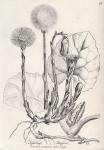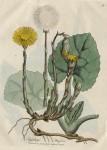
 (Some plants in the Asteraceae contain hepatotoxic pyrrolizidine alkaloids. Coltsfoot is among them. More info here: Livertoxic PAs --Henriette.)
(Some plants in the Asteraceae contain hepatotoxic pyrrolizidine alkaloids. Coltsfoot is among them. More info here: Livertoxic PAs --Henriette.)
Synonyma. Petasites scapo unifloro, flore radiato, Hal. Stirp. Helv. n. 143.
Bechium, Dodon. Pempt. 586.
Tussilago vulgaris. Bauh. Pin. 197. Zannich. Venez. t. 266.
Tussilago. Clus. Hist. 140. Camer. Epit. 590. Gerard, 811. Parkinson, 1220. Raii Hist. Plant, 259.
Tussilago Farfara. Curtis Flor. Lond. Relhan. Flor. Cantab. Withering. Botan. Arrang. p,
904.
(greek) [Supposed to be derived from (greek), tussis, hence Tussilago.] Dioscorid. Hippoc. &c.
Class Syngenesia. Ord. Polygamia Superflua. L. Gen. Pl. 952.
Ess. Gen. Ch. Recept. nudum. Pappus simplex. Cal. squamae aequales, discum aequantes, submembranaceae.
Spec. Char. T. scapo unifloro imbricato, fol. subcordatis angulatis denticulatis.
The root is long, round, tapering, creeping, and sends off many small short fibres; the stalks are furrowed, downy, simple, six or eight inches high, beset with several scaly leaves, of a brownish pink colour, and closely embracing the stem; the leaves are obtusely heart-shaped, angular, irregularly indented, above of a bright green colour, beneath white, downy, and stand upon long roundish radical foot-stalks; the flowers are compound, large, and yellow; the florets in the disc are hermaphrodite, tubular, the limb is cut into five acute segments, which curl outwardly; the antherae, by uniting, form a tube, but their apices are separate and pointed; the germen is short, the style filiform, longer than the antherae, and the stigma is round: the florets at the circumference are female, tubular at the base, and the limb is long and linear; the germen is oblong; the stigma bifid; the seed is oblong, and of a pale-brown colour, crowned with simple down; the calyx is cylindrical, and the leaflets or squamae are oblong, pointed, and alternately narrower. It is common in moist clayey places, and the flowers appear sometime before the leaves, in March or April.
The sensible qualities of Tussilago are very inconsiderable; it has a rough mucilaginous taste, but no remarkable smell. The leaves have always been of great fame, as possessing demulcent and pectoral virtues; of course, it is esteemed useful in pulmonary consumptions, coughs, asthmas, and in various catarrhal symptoms. [We might, without exception, cite every writer upon the Materia Medica. Percival found it also useful in hectic diarrhoeas. Essays Med. & Exper. vol. 2. p. 224. Cartheuser advises it to be given with the roots of Dandelion. Mat. Med. 416. The juice, liberally drunk, has been beneficial in calculous complaints. Comm. Lit. Nor. 1736, p. 194.] Fuller, in his Medicina Gymnastica, [p. 84.] recommends Coltsfoot as a valuable medicine in scrophula; and Dr. Cullen, who does not allow it any powers as a demulcent and expectorant, found it serviceable in some strumous affections. [Every part of the plant has been medicinally employed for the same purpose, but more usually the leaves, and these are the principal ingredient in the British herb tobacco. It is remarkable, that the smoking of this plant has the recommendation of Dioscorides, Galen, Pliny, Boyle, &c. Et adhuc hodie plebs in suecia instar tabaci contra tussim fugit. Lin. Flor. Suec. p. 289, and under the direction of Pliny it is certainly an efficacious remedy— in singulos haustus, passum gustandum est. lib. 26. c. 6. p. 651.] It may be used as tea, or given in the way of infusion, to which liquorice-root or honey, may be a useful addition.

